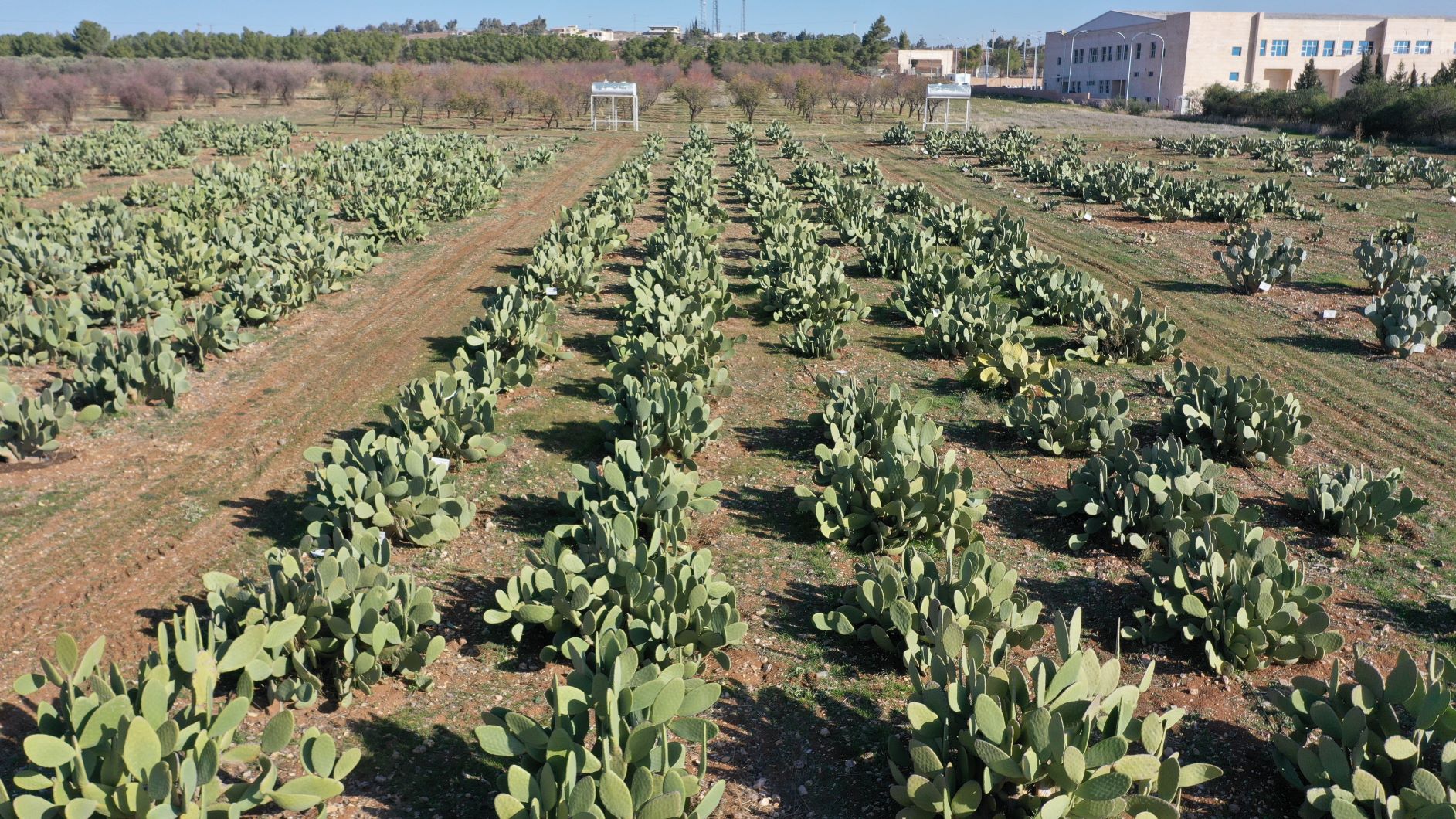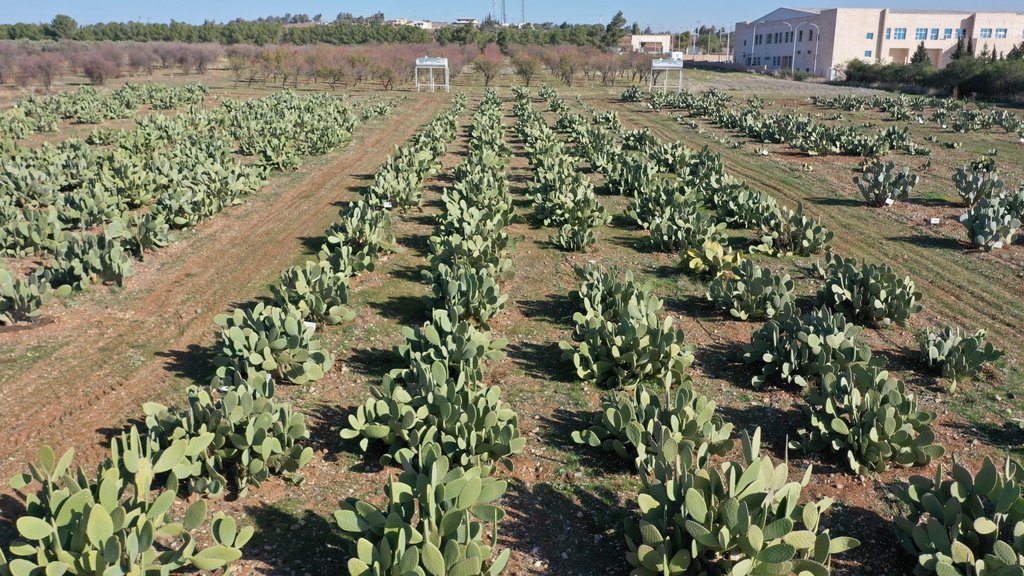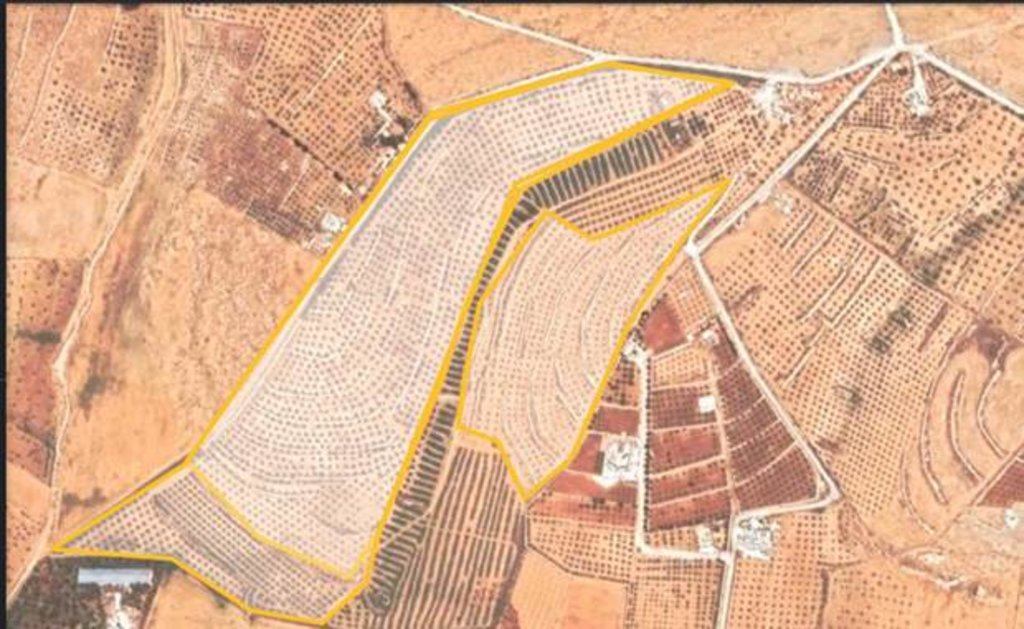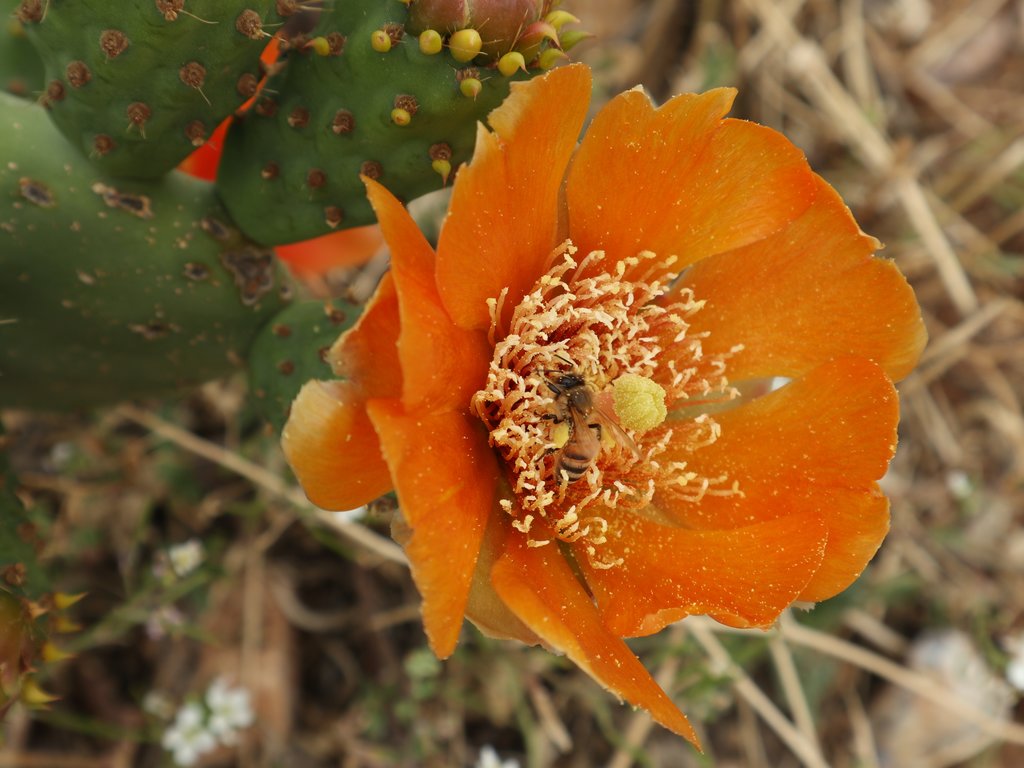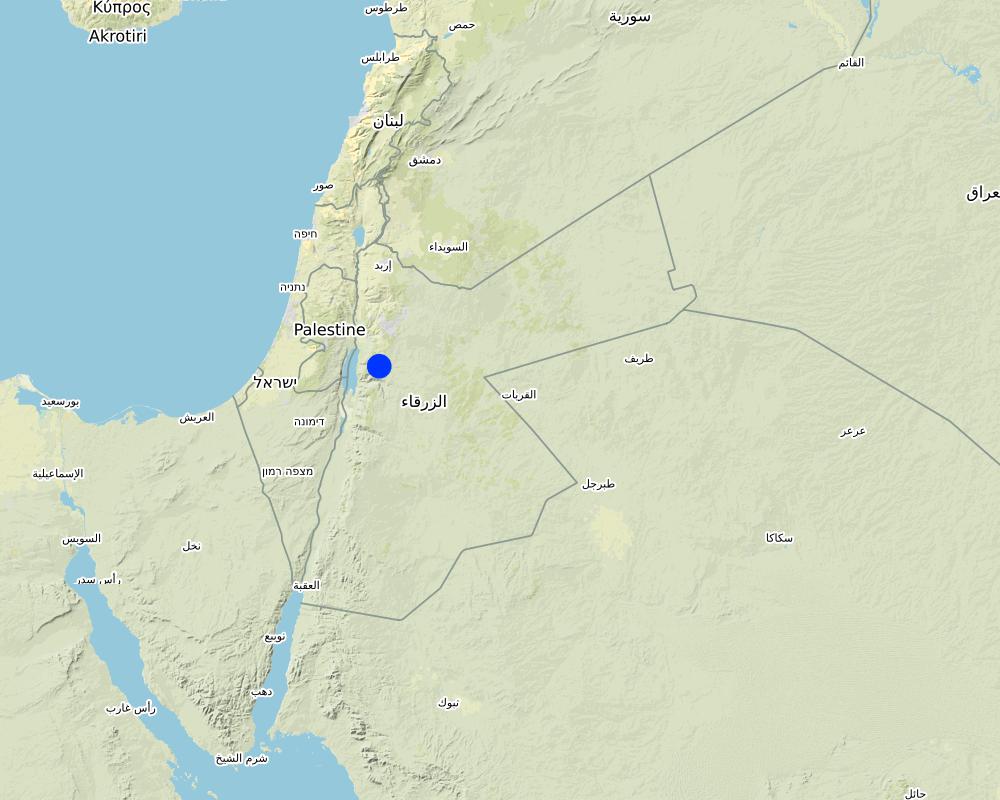Cactus Fruit Plantation in Arid Dry Lands [Jordanie]
- Création :
- Mise à jour :
- Compilateur : Joren Verbist
- Rédacteur : –
- Examinateur : Rima Mekdaschi Studer
technologies_5847 - Jordanie
Voir les sections
Développer tout Réduire tout1. Informations générales
1.2 Coordonnées des personnes-ressources et des institutions impliquées dans l'évaluation et la documentation de la Technologie
Personne(s)-ressource(s) clé(s)
Research Team Leader of Rangeland Ecology and Forages:
Louhaichi Mounir
International Center of Agriculture Research in the Dry Areas (ICARDA)
Jordanie
Research Associate Coordinator of Forage Systems:
Hassan Sawsan
International Center of Agriculture Research in the Dry Areas (ICARDA)
Jordanie
Nom du projet qui a facilité la documentation/ l'évaluation de la Technologie (si pertinent)
ICARDA Institutional Knowledge Management InitiativeNom du ou des institutions qui ont facilité la documentation/ l'évaluation de la Technologie (si pertinent)
International Center for Agricultural Research in the Dry Areas (ICARDA) - Liban1.3 Conditions relatives à l'utilisation par WOCAT des données documentées
Le compilateur et la(les) personne(s) ressource(s) acceptent les conditions relatives à l'utilisation par WOCAT des données documentées:
Oui
1.4 Déclaration sur la durabilité de la Technologie décrite
Est-ce que la Technologie décrite ici pose problème par rapport à la dégradation des terres, de telle sorte qu'elle ne peut pas être déclarée comme étant une technologie de gestion durable des terres?
Non
2. Description de la Technologie de GDT
2.1 Courte description de la Technologie
Définition de la Technologie:
This technology is based on the natural advantages and the multi-purpose usage of spineless cactus pear (Opuntia fiscus-indica), to cultivate marginal lands in Jordan, generating environmental and socio-economic benefits.
2.2 Description détaillée de la Technologie
Description:
In the arid parts of Jordan with limited rainfall, little irrigation, high water evaporation, poor soil quality and unsustainable land management result in land degradation (erosion and salinization) and productivity loss. Therefore, the International Center Agricultural Research in the Dry Areas (ICARDA) and National Agricultural Research Centre of Jordan (NARC) organized field days (started in 2014) to disseminate knowledge regarding the cultivation of the cactus pear, Opuntia ficus-indica, cactus crop. Cacti can cope with high temperatures and grow well in (semi)-arid areas with 250-600mm annual rainfall or where irrigation is available. Additionally, the plant is very resilient as it can withstand a long dry season due to its high water-content and water-use -efficiency, which are a result of its morphology (waxy cuticle, no actual leaves) and the Crassulacean Acid Metabolism (CAM). In CAM plant, stomata in the leaves remain shut during the day to reduce evapotranspiration, but open at night to collect and fix carbon dioxide (CO2). In general, cacti have multiple products that benefit local livelihoods, these are for example stable production of fodder for livestock and fruits for human consumption. Also, cactus can grow and produce requiring few inputs such as fertilizers, therefore marginal lands are well suited for cactus cultivation.
The market for cactus fruits is very promising in Jordan. Nowadays, there is high demand for cactus fruits as people grow fond of the fruits but also for medicinal uses. This documentation is focused on a farm covering roughly 10 hectares, where cactus was planted due to its socio-economic and environmental advantages i.e. the high prices for cactus fruits and the ability of cactus to grow in marginal lands with little input and cover the soil hence preventing soil erosion. However, the farm is not located ideally for cactus cultivation. Therefore, the farm is currently intensively managed in terms of fertilizer application and the irrigation. The previous land use was poor cultivation of barley to feed (grazing) sheep and goats. This led to little soil cover resulting in land degradation in the form of erosion. The farmer paid for the establishment of the cactus-plantation. The cacti are spaced by 4 meters between plants and 3 meters between rows. This spacing is specific for fruit production, in case of fodder production a higher crop density is recommended. The cacti are planted on the contours in pits (40 centimetres depth and diameter) to ensure rain-water collection and efficient fertilizer application as the farm is situated on a 15% slope. The cacti reduce erosion as the roots hold the soil together. Field preparation for the establishment of the cactus field includes: (1) soil scrapping; (2) deep soil ploughing; (3) surface soil ploughing; and (4) pit digging. No fertilizer was applied in the establishment stage. Recurrent activities and costs are weeding, applying fertilizer and organic manure, maintaining the pits and harvesting. 200 kilograms per hectare of inorganic fertilizer (NPK) is applied between March and May. A total of 4 tons per hectare of organic manure is applied in September-November. These activities are non-mechanized, and therefore labour intensive.
The farm receives less than 200mm of annual rainfall and a public dam for irrigation is available. Therefore, the farmer invests in three water tanks to store water brought from the dam using his own truck, and in a drip irrigation system for high irrigation efficiency. The farm is irrigated by 360 cubic meter per month, divided in three events. The costs per cubic meter is 0.95 Jordanian Dinar (JOD) (including transportation costs). Before the realization of the drip irrigation system, the cacti were watered by hand (19991-2015). During the initial three years, cacti produce no fruits making the short-term return on investment rather negative. Currently, the cactus-plantation produces 32.5 ton/ha, equivalent to 65 kg /plant. The average net income per hectare varies between 1650 JOD to 2750 JOD. This makes the farmer relatively medium- wealthy with respect to the area. Most costs are induced by labour as the farmer uses manual weeding, harvesting and fertilizer application.
Even though the cultivation of cacti for its fruits on marginal lands has many benefits like the reduction in erosion, stable production, high output/input efficiency and good prices. There are some weaknesses, for example the relative young market of cactus products in Jordan compared to Tunisia. The Tunisian market for cactus products has a longer history, a high demand for other cactus-products like oil and juice and a better infrastructure (e.g. processing units) exist. These create more consistent prices for farmers, so less price drops during harvesting periods. Another weak point is the fact that cacti are cultivated in mono-culture. This significantly increases the risk of new pests and potential damage of the cultivated crop.
To conclude, this documentation shows that even though the selected farm does not represent an ideal site for cactus pear cultivation, the implementation of cacti is socio-economically and environmentally appropriate to cultivate dry marginal lands as cacti uses water and nutrients highly efficient while reducing land degradation. Therefore, the out-scaling of cacti is very valuable and a practical option to fight land degradation and enhance smallholder’s income.
2.3 Photos de la Technologie
2.5 Pays/ région/ lieux où la Technologie a été appliquée et qui sont couverts par cette évaluation
Pays:
Jordanie
Spécifiez la diffusion de la Technologie:
- répartie uniformément sur une zone
Si la Technologie est uniformément répartie sur une zone, précisez la superficie couverte (en km2):
0,09
S'il n'existe pas d'informations exactes sur la superficie, indiquez les limites approximatives de la zone couverte:
- < 0,1 km2 (10 ha)
Est-ce que les sites dans lesquels la Technologie est appliquée sont situés dans des zones protégées en permanence?
Non
Map
×2.6 Date de mise en œuvre de la Technologie
Indiquez l'année de mise en œuvre:
2014
2.7 Introduction de la Technologie
Spécifiez comment la Technologie a été introduite: :
- au cours d'expérimentations / de recherches
- par le biais de projets/ d'interventions extérieures
3. Classification de la Technologie de GDT
3.1 Principal(aux) objectif(s) de la Technologie
- améliorer la production
- réduire, prévenir, restaurer les terres dégradées
- s'adapter au changement et aux extrêmes climatiques et à leurs impacts
- créer un impact économique positif
- créer un impact social positif
3.2 Type(s) actuel(s) d'utilisation des terres, là où la Technologie est appliquée
Les divers types d'utilisation des terres au sein du même unité de terrain: :
Non

Terres cultivées
- Plantations d’arbres ou de buissons
Plantations d'arbres et d'arbustes - Précisez les cultures:
- cactus, cactus-like (e.g. opuntia)
Est-ce que les cultures intercalaires sont pratiquées?
Non
Est-ce que la rotation des cultures est appliquée?
Non
3.3 Est-ce que l’utilisation des terres a changé en raison de la mise en œuvre de la Technologie ?
Est-ce que l’utilisation des terres a changé en raison de la mise en œuvre de la Technologie ?
- Oui (Veuillez remplir les questions ci-après au regard de l’utilisation des terres avant la mise en œuvre de la Technologie)
Les divers types d'utilisation des terres au sein du même unité de terrain: :
Oui
Précisez l'utilisation mixte des terres (cultures/ pâturages/ arbres):
- Agropastoralisme (y compris les systèmes culture-élevage intégrés)

Terres cultivées
- Cultures annuelles
Cultures annuelles - Précisez les cultures:
- céréales - orge
Est-ce que les cultures intercalaires sont pratiquées?
Non
Est-ce que la rotation des cultures est appliquée?
Non

Pâturages
Pâturage extensif:
- Pastoralisme de type semi-nomade
Type d'animal:
- caprine
- ovins
Est-ce que la gestion intégrée cultures-élevage est pratiquée?
Non
Produits et services:
- viande
- lait
3.4 Approvisionnement en eau
Approvisionnement en eau des terres sur lesquelles est appliquée la Technologie:
- pleine irrigation
Commentaires:
360m^3 of water applied through drip irrigation. The annual precipitation is less than 200mm
3.5 Groupe de GDT auquel appartient la Technologie
- Amélioration de la couverture végétale/ du sol
- gestion de l'irrigation (incl. l'approvisionnement en eau, le drainage)
3.6 Mesures de GDT constituant la Technologie

pratiques végétales
- V1: Couverture d’arbres et d’arbustes

structures physiques
- S7: Collecte de l'eau/ approvisionnent en eau/ équipement d'irrigation

modes de gestion
- M1: Changement du type d’utilisation des terres
3.7 Principaux types de dégradation des terres traités par la Technologie

érosion hydrique des sols
- Wt: perte de la couche superficielle des sols (couche arable)/ érosion de surface

érosion éolienne des sols
- Et: perte de la couche superficielle des sols (couche arable)

dégradation chimique des sols
- Cs: salinisation/ alcalinisation

dégradation physique des sols
- Pk: scellage et encroûtement

dégradation biologique
- Bc: réduction de la couverture végétale
- Bq: baisse de la quantité/ biomasse
3.8 Prévention, réduction de la dégradation ou réhabilitation des terres dégradées
Spécifiez l'objectif de la Technologie au regard de la dégradation des terres:
- prévenir la dégradation des terres
- réduire la dégradation des terres
4. Spécifications techniques, activités, intrants et coûts de mise en œuvre
4.1 Dessin technique de la Technologie
Spécifications techniques (associées au dessin technique):
The rows are placed 3 meters apart (A), and are located on the contour for rainwater collection as the farm field has a slope of 15% (E). The interspace is 4 meters (D). The cacti are planted in pits that have a diameter of roughly 40 centimeters (C) and a depth of 40 centimeters (B).
Auteur:
Meike Kleinlugtenbeld & Joren Verbist
Date:
20/12/2020
4.2 Informations générales sur le calcul des intrants et des coûts
Spécifiez la manière dont les coûts et les intrants ont été calculés:
- par superficie de la Technologie
Indiquez la taille et l'unité de surface:
9.1 hectare
autre/ monnaie nationale (précisez):
JOD
Indiquez le taux de change des USD en devise locale, le cas échéant (p.ex. 1 USD = 79.9 réal brésilien): 1 USD = :
0,71
Indiquez le coût salarial moyen de la main d'œuvre par jour:
20
4.3 Activités de mise en place/ d'établissement
| Activité | Calendrier des activités (saisonnier) | |
|---|---|---|
| 1. | Soil scrapping | Prior to planting |
| 2. | Deep soil ploughing | Prior to planting |
| 3. | Surface soil ploughing | Prior to planting |
| 4. | Pit digging | Prior to planting |
| 5. | Planting cacti | Last third of the dry season (August - October) |
| 6. | Establishment of drip irrigation | If feasible (This case 2015) |
Commentaires:
Drip irrigation can be establishment when feasible (e.g. funds available). It would greatly enhance cactus-production but cacti can survive and produce without it.
4.4 Coûts et intrants nécessaires à la mise en place
| Spécifiez les intrants | Unité | Quantité | Coûts par unité | Coût total par intrant | % des coût supporté par les exploitants des terres | |
|---|---|---|---|---|---|---|
| Main d'œuvre | Pit Digging & Planting | Person Hour | 47,0 | 100,0 | 4700,0 | 100,0 |
| Main d'œuvre | 100,0 | |||||
| Main d'œuvre | 100,0 | |||||
| Equipements | Soil Scrapping (Jackhammer) | Machine-Hour | 35,0 | 200,0 | 7000,0 | 100,0 |
| Equipements | Deep Soil Ploughing (Tractor) | Machine-Hour | 9,0 | 250,0 | 2250,0 | 100,0 |
| Equipements | Surface Soil Ploughing | Machine-Hour | 9,0 | 250,0 | 2250,0 | 100,0 |
| Matériel végétal | Cactus Pads | Pad | 5000,0 | 0,1 | 500,0 | 100,0 |
| Matériaux de construction | Drip Irrigation (including labour for installation: 14 person days) | Whole System | 1,0 | 13700,0 | 13700,0 | 100,0 |
| Matériaux de construction | Water Tanks (including labour for construction: 10 person days) | Tank | 3,0 | 500,0 | 1500,0 | 100,0 |
| Coût total de mise en place de la Technologie | 31900,0 | |||||
| Coût total de mise en place de la Technologie en dollars américains (USD) | 44929,58 | |||||
Commentaires:
The cacti are planted in pits. The digging of pits and planting of the cactus pads into the pits is done simultaneously, hence this is grouped in terms of labour. For soil preparation (scrapping and ploughing), the costs of labour are included in the machine costs as this was a hired service. The installation of the irrigation system and the construction of the tanks was each offered as a package and hence include the costs of labour.
4.5 Activités d'entretien/ récurrentes
| Activité | Calendrier/ fréquence | |
|---|---|---|
| 1. | NPK Fertilizer (1x) | March - May |
| 2. | NPK Fertilizer (1x) | September - November |
| 3. | NPK Fertilizer (1x) | December - February |
| 4. | Organic Manure Application | September - November |
| 5. | Manual Weeding (2x) | March - May |
| 6. | Maintenance of planting pits | April |
| 7. | Harvesting | August - September |
4.6 Coûts et intrants nécessaires aux activités d'entretien/ récurrentes (par an)
| Spécifiez les intrants | Unité | Quantité | Coûts par unité | Coût total par intrant | % des coût supporté par les exploitants des terres | |
|---|---|---|---|---|---|---|
| Main d'œuvre | NPK Fertilizer Application | Person-Day | 9,0 | 20,0 | 180,0 | 100,0 |
| Main d'œuvre | Organic Manure Application | Person-Day | 7,0 | 20,0 | 140,0 | 100,0 |
| Main d'œuvre | Total Weeding | Person-Day | 200,0 | 15,0 | 3000,0 | 100,0 |
| Main d'œuvre | Harvesting / Fruit Grabbing | Person-Day | 280,0 | 20,0 | 5600,0 | 100,0 |
| Equipements | Irrigation Management | Person Hour | 252,0 | 100,0 | ||
| Engrais et biocides | NPK Fertilizer | Ton | 2,0 | 1000,0 | 2000,0 | 100,0 |
| Engrais et biocides | Organic Manure | Ton | 40,0 | 30,0 | 1200,0 | 100,0 |
| Autre | Pit Maintenance | Per Pit | 4550,0 | 0,25 | 1137,5 | 100,0 |
| Autre | Water for Irrigation (360m3 per month) | Kubic Metre | 4320,0 | 0,95 | 4104,0 | 100,0 |
| Coût total d'entretien de la Technologie | 17361,5 | |||||
| Coût total d'entretien de la Technologie en dollars américains (USD) | 24452,82 | |||||
Commentaires:
Irrigation Management consists of filling the tanks and using the drip irrigation.
4.7 Facteurs les plus importants affectant les coûts
Décrivez les facteurs les plus importants affectant les coûts :
On the farm most work (e.g. weeding) is done manually. Therefore, the cost of labour contributes significantly to the total cost.
5. Environnement naturel et humain
5.1 Climat
Précipitations annuelles
- < 250 mm
- 251-500 mm
- 501-750 mm
- 751-1000 mm
- 1001-1500 mm
- 1501-2000 mm
- 2001-3000 mm
- 3001-4000 mm
- > 4000 mm
Spécifiez la pluviométrie moyenne annuelle (si connue), en mm:
200,00
Zone agro-climatique
- semi-aride
- aride
5.2 Topographie
Pentes moyennes:
- plat (0-2 %)
- faible (3-5%)
- modéré (6-10%)
- onduleux (11-15%)
- vallonné (16-30%)
- raide (31-60%)
- très raide (>60%)
Reliefs:
- plateaux/ plaines
- crêtes
- flancs/ pentes de montagne
- flancs/ pentes de colline
- piémonts/ glacis (bas de pente)
- fonds de vallée/bas-fonds
Zones altitudinales:
- 0-100 m
- 101-500 m
- 501-1000 m
- 1001-1500 m
- 1501-2000 m
- 2001-2500 m
- 2501-3000 m
- 3001-4000 m
- > 4000 m
Indiquez si la Technologie est spécifiquement appliquée dans des:
- non pertinent
5.3 Sols
Profondeur moyenne du sol:
- très superficiel (0-20 cm)
- superficiel (21-50 cm)
- modérément profond (51-80 cm)
- profond (81-120 cm)
- très profond (>120 cm)
Texture du sol (de la couche arable):
- moyen (limoneux)
- fin/ lourd (argile)
Texture du sol (> 20 cm sous la surface):
- moyen (limoneux)
- fin/ lourd (argile)
Matière organique de la couche arable:
- faible (<1%)
5.4 Disponibilité et qualité de l'eau
Profondeur estimée de l’eau dans le sol:
5-50 m
Disponibilité de l’eau de surface:
faible/ absente
Qualité de l’eau (non traitée):
faiblement potable (traitement nécessaire)
La qualité de l'eau fait référence à:
à la fois les eaux souterraines et de surface
La salinité de l'eau est-elle un problème? :
Oui
La zone est-elle inondée?
Non
5.5 Biodiversité
Diversité des espèces:
- faible
Diversité des habitats:
- faible
5.6 Caractéristiques des exploitants des terres appliquant la Technologie
Sédentaire ou nomade:
- Sédentaire
Orientation du système de production:
- exploitation mixte (de subsistance/ commerciale)
Revenus hors exploitation:
- 10-50% de tous les revenus
Niveau relatif de richesse:
- moyen
Individus ou groupes:
- individu/ ménage
Niveau de mécanisation:
- travail manuel
- traction animale
Genre:
- hommes
Age des exploitants des terres:
- jeunes
- personnes d'âge moyen
5.7 Superficie moyenne des terres utilisées par les exploitants des terres appliquant la Technologie
- < 0,5 ha
- 0,5-1 ha
- 1-2 ha
- 2-5 ha
- 5-15 ha
- 15-50 ha
- 50-100 ha
- 100-500 ha
- 500-1 000 ha
- 1 000-10 000 ha
- > 10 000 ha
Cette superficie est-elle considérée comme de petite, moyenne ou grande dimension (en se référant au contexte local)?
- grande dimension
5.8 Propriété foncière, droits d’utilisation des terres et de l'eau
Propriété foncière:
- groupe
Droits d’utilisation des terres:
- individuel
Droits d’utilisation de l’eau:
- communautaire (organisé)
Est-ce que les droits d'utilisation des terres sont fondés sur un système juridique traditionnel?
Oui
Précisez:
Most government land is open access.
Commentaires:
The water comes from a public dam.
5.9 Accès aux services et aux infrastructures
santé:
- pauvre
- modéré
- bonne
éducation:
- pauvre
- modéré
- bonne
assistance technique:
- pauvre
- modéré
- bonne
emploi (par ex. hors exploitation):
- pauvre
- modéré
- bonne
marchés:
- pauvre
- modéré
- bonne
énergie:
- pauvre
- modéré
- bonne
routes et transports:
- pauvre
- modéré
- bonne
eau potable et assainissement:
- pauvre
- modéré
- bonne
services financiers:
- pauvre
- modéré
- bonne
6. Impacts et conclusions
6.1 Impacts sur site que la Technologie a montrés
Impacts socio-économiques
Production
production agricole
qualité des cultures
Disponibilité et qualité de l'eau
demande pour l'eau d'irrigation
Revenus et coûts
dépenses pour les intrants agricoles
revenus agricoles
diversité des sources de revenus
Impacts socioculturels
sécurité alimentaire/ autosuffisance
connaissances sur la GDT/ dégradation des terres
Impacts écologiques
Sols
humidité du sol
couverture du sol
perte en sol
cycle/ recharge des éléments nutritifs
matière organique du sol/ au dessous du sol C
Biodiversité: végétale, animale
biomasse/ au dessus du sol C
Réduction des risques de catastrophe et des risques climatiques
impacts de la sécheresse
6.3 Exposition et sensibilité de la Technologie aux changements progressifs et aux évènements extrêmes/catastrophes liés au climat (telles que perçues par les exploitants des terres)
Changements climatiques progressifs
Changements climatiques progressifs
| Saison | Augmentation ou diminution | Comment la Technologie fait-elle face à cela? | |
|---|---|---|---|
| températures annuelles | augmente | très bien |
Extrêmes climatiques (catastrophes)
Catastrophes météorologiques
| Comment la Technologie fait-elle face à cela? | |
|---|---|
| averse de grêle locale | pas bien |
| tempête de neige locale | pas bien |
Catastrophes climatiques
| Comment la Technologie fait-elle face à cela? | |
|---|---|
| canicule | très bien |
| vague de froid | pas bien |
| conditions hivernales extrêmes | pas bien |
| sécheresse | très bien |
Catastrophes biologiques
| Comment la Technologie fait-elle face à cela? | |
|---|---|
| maladies épidémiques | pas bien |
Commentaires:
Hail storms and snow storms may occur, but very rarely. An example of an epidemic disease is black spot or rots.
6.4 Analyse coûts-bénéfices
Quels sont les bénéfices comparativement aux coûts de mise en place (du point de vue des exploitants des terres)?
Rentabilité à court terme:
légèrement négative
Rentabilité à long terme:
légèrement positive
Quels sont les bénéfices comparativement aux coûts d'entretien récurrents (du point de vue des exploitants des terres)?
Rentabilité à court terme:
légèrement positive
Rentabilité à long terme:
légèrement positive
Commentaires:
The Net Income per hectare varies between 1650 and 2750 JOD.
6.5 Adoption de la Technologie
- 1-10%
Si disponible, quantifiez (nombre de ménages et/ou superficie couverte):
200 ha
De tous ceux qui ont adopté la Technologie, combien d'entre eux l'ont fait spontanément, à savoir sans recevoir aucune incitation matérielle, ou aucune rémunération? :
- 91-100%
Commentaires:
All farmers who planted cactus started after requiring knowledge about the good prices for cactus fruits and the natural advantages of the cacti. So, this specific technology (Irrigated Cactus plantation) is not necessarily adopted by many farmers. But the use of cacti as a resilient, efficient and profitable crops is however adopted among many other farmers.
6.6 Adaptation
La Technologie a-t-elle été récemment modifiée pour s'adapter à l'évolution des conditions?
Oui
Si oui, indiquez à quel changement la Technologie s'est adaptée:
- évolution des marchés
Spécifiez l'adaptation de la Technologie (conception, matériaux/ espèces, etc.):
The market demands increase for cactus pears. This results in different crop-spacing because cactus for pear production requires wider spacing, while cactus for fodder production can be planted more dense. Hence, changing market demands for the different products of cactus require different agronomic practices.
6.7 Points forts/ avantages/ possibilités de la Technologie
| Points forts/ avantages/ possibilités du point de vue de l'exploitant des terres |
|---|
| The cacti are highly productive with minimum inputs. |
| It does not require much water, which is important as irrigation water availability is a bottleneck for the farmer as well as for most areas in Jordan. |
| The cacti are even productive in poor soil and by growing cacti on these soils, it also reduces erosion. |
| The reduced risk of drought deteriorated yields is important as climate change leads to more extreme weather event, such as droughts. This will only increase in the future. Therefore the cactus's ability to cope with climate change (resilience to climate fluctuations) is a great advantage and increasingly important. |
| Points forts/ avantages/ possibilités du point de vue du compilateur ou d'une autre personne ressource clé |
|---|
| Due to the suitability of cacti to be cultivated in marginal lands, the soil is partly covered permanently by vegetation in these areas which protects these degraded lands. Therefore, cacti cultivation could offer incentive to prevent land degradation. |
| The technology offers increased resilience of the environment and its involved livelihoods. This is because cacti are more resilient to climate change induced effects such as increased droughts and increasing (summer) temperatures, as result of their high-water content and efficiency. Therefore, this technology is better suited for the future. |
6.8 Faiblesses/ inconvénients/ risques de la Technologie et moyens de les surmonter
| Faiblesses/ inconvénients/ risques du point de vue de l’exploitant des terres | Comment peuvent-ils être surmontés? |
|---|---|
| The significant cost related to labour. | According to the farmer there were no alternatives. |
| Marketing can be considered a weakness as during harvest, the supply of cactus fruits was high and thus the selling-prices were low. | By investing in manufacturing/ processing the cacti and stably provide the market with other cactus-products, such as the Tunisian market. |
| The increased risk of new pests. | More awareness is required so the new pests can be identified, allowing proper and timely action. |
| The absence of agro-industrial processing units. Currently, the market demand is mostly related to the cactus fruits. However, cacti offer more such as seeds for oil extraction (such as the Tunisian cactus value chain) . | Investments to enhance cactus-value chain as is done in Tunisia. |
| Faiblesses/ inconvénients/ risques du point de vue du compilateur ou d'une autre personne ressource clé | Comment peuvent-ils être surmontés? |
|---|---|
| The possible knowledge gap for farmers to switch from their conventional/traditional agricultural practices to a more innovative one could be a bottleneck for out-scaling the technology. | This bottleneck can be overcome, by developing social capital such as (e.g.) institutions or farmers networks to disseminate knowledge. A good example is the field days for farmers organized by NARC and ICARDA. |
| The risks of pests and diseases is a weakness of the cacti as these plants are vulnerable to this. Also, due to the density and mono-cropping of the cacti, the pest/ disease may spread easily and rapidly over the field. Eventually, risking the production of the cacti, thus possibly reducing the income of local farmers. | A solution may be found in changing the agricultural activities. An example of such a possible solution is the introduction of intercropping, this could increase bio-diversity and reduce the potential loss of income in case of a pest-outbreak. |
7. Références et liens
7.1 Méthodes/ sources d'information
- visites de terrain, enquêtes sur le terrain
- interviews/entretiens avec les exploitants des terres
- interviews/ entretiens avec les spécialistes/ experts de GDT
Quand les données ont-elles été compilées (sur le terrain)?
06/12/2020
7.3 Liens vers les informations pertinentes en ligne
Titre/ description:
Fethi Ghouhis, Mounir Louhaichi, Ali Nefzaoui. (12/8/2019). Cactus (Opuntia ficus-indica) utilization for rehabilitating rangelands in arid regions of Tunisia. Acta Horticulturae, 1247, pp. 95-102.
URL:
https://hdl.handle.net/20.500.11766/10394
Titre/ description:
Mounir Louhaichi, Sawsan Hassan, Giorgia Liguori. (30/12/2019). Manual: Cactus Pear Agronomic Practices.
URL:
https://hdl.handle.net/20.500.11766/10558
Titre/ description:
HO de Waal, Mounir Louhaichi, Makiko Taguchi, Herman Fouché, Maryna de Wit. (25/1/2015). Development of a cactus pear agro-industry for the sub-Sahara Africa Region. Bloemfontein, South Africa: HO de Waal (Curator).
URL:
https://hdl.handle.net/20.500.11766/7109
Titre/ description:
Mounir Louhaichi, Sawsan Hassan. (7/10/2018). Managing rangelands: promoting sustainable shrub species: Opuntia ficus-indica (L. ) Mill: a sustainable fodder plant for the dry areas. Beirut, Lebanon: International Center for Agricultural Research in the Dry Areas (ICARDA).
URL:
https://hdl.handle.net/20.500.11766/9048
Titre/ description:
Mourad Rekik, Mounir Louhaichi. (9/3/2014). Cactusnet: Promoting the social and ecological benefits of cactus production: Enhancing sheep reproduction through cactus-based feed diets. Beirut, Lebanon: International Center for Agricultural Research in the Dry Areas (ICARDA).
URL:
https://hdl.handle.net/20.500.11766/8523
Titre/ description:
Hichem Ben Salem, Mounir Louhaichi. (30/11/2014). Cactusnet: Promoting the social and ecological benefits of cactus production: Promoting Cactus as an alternative and sustainable livestock feed. Beiurt, Lebanon: International Center for Agricultural Research in the Dry Areas (ICARDA)
URL:
https://hdl.handle.net/20.500.11766/5454
Titre/ description:
Ali Nefzaoui, Mounir Louhaichi, Hichem Ben Salem. (30/1/2014). Cactus as a Tool to Mitigate Drought and to Combat Desertification. Journal of Arid Land Studies, 24(1), pp. 121-124.
URL:
https://hdl.handle.net/20.500.11766/7319
Titre/ description:
Mounir Louhaichi (Producer), Sawsan Hassan (Director). (17/1/2021). Best Agronomic Practices for establishing cactus Orchard. Jordan: International Center for Agricultural Research in the Dry Areas (ICARDA) (Executive Producer).
URL:
https://hdl.handle.net/20.500.11766/12374
Liens et modules
Développer tout Réduire toutLiens
Aucun lien
Modules
Aucun module trouvé


